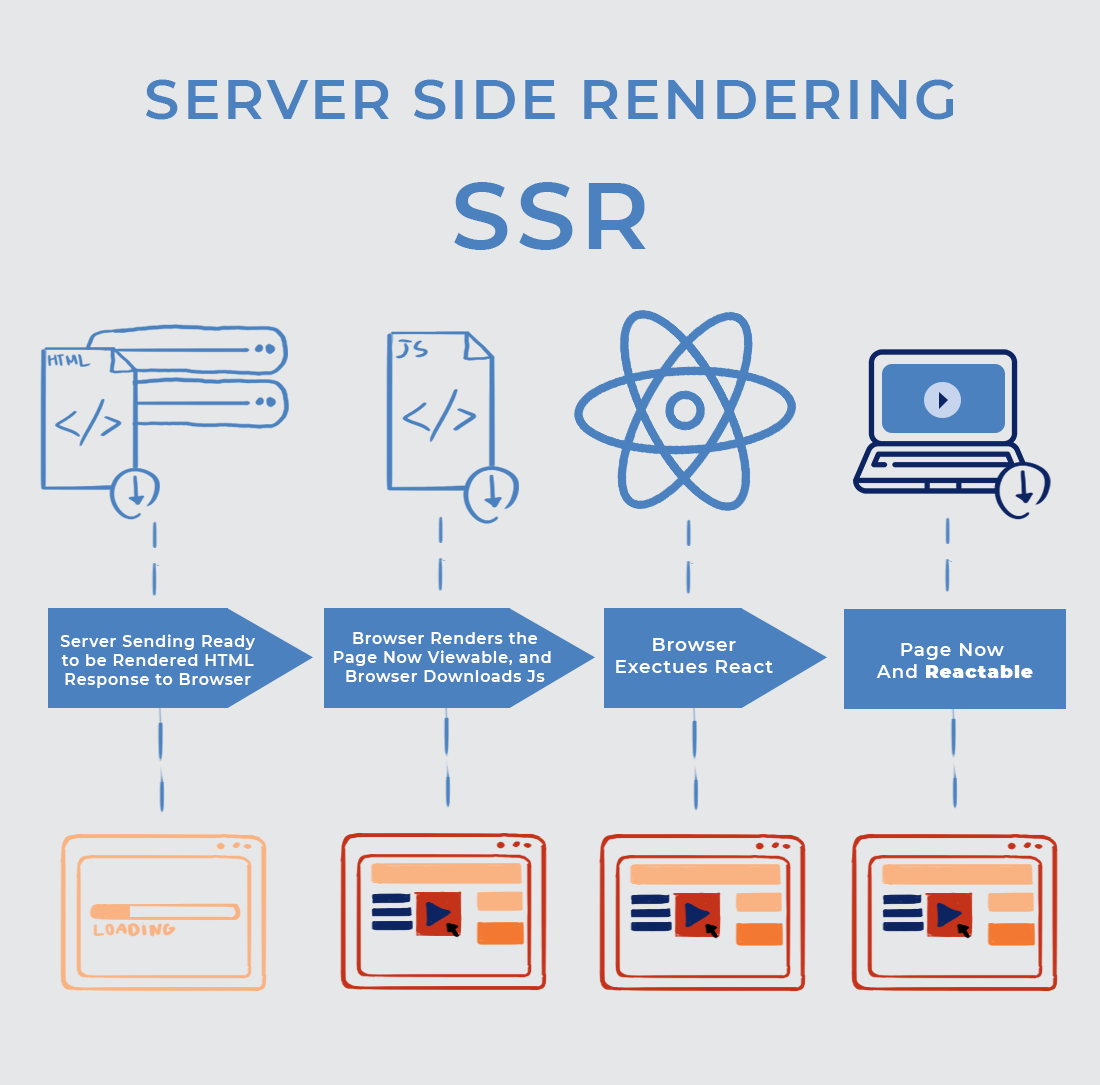Exploring Server-side Rendering for React Applications

Server-side rendering (SSR) is a technique in web development where the HTML content of a web page is generated on the server before sending it to the client. This contrasts with client-side rendering (CSR), where the HTML is generated on the client-side using JavaScript.

SSR has several advantages over CSR. First, it can improve the performance of a web page by reducing the amount of time it takes for the page to load. This is because the HTML is already generated on the server, so the client does not have to wait for the JavaScript to download and execute before it can start rendering the page.

Second, SSR can improve the search engine optimization (SEO) of a web page. This is because search engines can directly index the HTML content of a page that is rendered on the server, which is not possible with CSR.
Finally, SSR can improve the security of a web page by preventing malicious JavaScript from being executed on the client-side. This is because the HTML is generated on the server, so the client does not have the opportunity to execute any malicious JavaScript.
However, SSR also has some disadvantages over CSR. First, it can be more complex to implement than CSR. This is because the HTML must be generated on the server, which requires additional code and configuration.
Second, SSR can be less responsive than CSR. This is because the HTML is generated on the server, so the client has to wait for the response from the server before it can start rendering the page.
Overall, SSR is a technique that can provide several benefits over CSR. However, it is important to weigh the benefits and disadvantages of SSR before deciding whether to use it for a particular project.
Here are some additional details about SSR:
- SSR is typically implemented using a Node.js server.
- The HTML content of a page is generated using a React component.
- The HTML is then sent to the client using a HTTP response.
- The client can then hydrate the HTML using JavaScript.
SSR is a powerful technique that can be used to improve the performance, SEO, and security of a React application. However, it is important to weigh the benefits and disadvantages of SSR before deciding whether to use it for a particular project.## Exploring Server-side Rendering For React Applications
Executive Summary
Server-side rendering (SSR) is a technique used in React applications to improve performance and enhance the user experience. By rendering the HTML markup on the server, SSR ensures that the page loads faster, making it more responsive and interactive for users. This article delves into the benefits and key considerations of using SSR for React applications, providing a comprehensive understanding of this crucial aspect of web development.
Introduction
React is a popular JavaScript library used for building user interfaces. It enables developers to create dynamic and interactive web applications efficiently. One key aspect of React applications is how they are rendered. Traditionally, React uses client-side rendering (CSR), where the HTML markup is generated in the browser using JavaScript. However, in scenarios where performance is paramount, server-side rendering becomes a valuable technique.
Advantages of Server-side Rendering
- Improved Performance: SSR significantly enhances the initial page load speed by sending pre-rendered HTML markup to the browser, reducing the rendering time and providing a faster user experience.
- Search Engine Optimization (SEO): SSR improves SEO by generating static HTML pages that can be indexed by search engines more efficiently than client-rendered JavaScript content.
- Better Accessibility: SSR aids assistive technologies like screen readers by providing the complete HTML structure, making the web application more accessible to users with disabilities.
- Consistency: SSR ensures consistency across different devices and browsers, regardless of the client’s capabilities, providing a uniform user experience.
- Reduced Server Load: SSR can reduce the load on the server by handling the rendering process on the server side, freeing up resources for other tasks.
Considerations for Server-side Rendering
- Increased Server Complexity: SSR adds complexity to the server-side codebase, requiring proper handling of dynamic content, caching, and data hydration.
- Potential Performance Bottlenecks: If the server-side rendering process becomes computationally intensive, it can lead to delays in the initial page load.
- Security Concerns: SSR can introduce security vulnerabilities if sensitive data is not handled properly during the rendering process on the server side.
- Compatibility: SSR may not be suitable for all React applications, especially for highly dynamic and interactive applications that rely heavily on client-side functionality.
- Server Configuration: Setting up SSR requires appropriate server configuration, including Node.js, a web server like Nginx or Apache, and appropriate middleware for handling SSR requests.
Conclusion
Server-side rendering is a critical technique that can enhance the performance, SEO, accessibility, and consistency of React applications. While it introduces additional complexity and potential bottlenecks, the benefits of SSR often outweigh the drawbacks when performance optimization is a priority. By carefully considering the advantages and considerations outlined in this article, developers can effectively leverage SSR to create high-quality web applications that deliver an exceptional user experience.
Keyword Phrase Tags
- Server-side rendering
- React applications
- Performance optimization
- SEO for React
- Accessibility in web development

Thank you for this educating post! I’ve been wanting to learn more about SSR for React, and this article has given me a great starting point. I’m excited to try out some of the techniques you’ve described.
This post is realy helps for me! Am beginer for react and this post is a really good start for me .I will try to use SSR for my next projects.
I’m not sure I agree with all of the points you made in this post. I think that client-side rendering is still a viable option for many React applications, and that SSR is not always the best choice. more over, examples haven’t clear enogh and hard to understand.
This is a correct post but title of the post should be ‘Exploring Server-side Rendering For React Js Applications’. and in the entire post , you should use the term React Js instead of React. because React is a library, React Js is a framework for developing web applications based on the React library.
I think this post is a bit too technical for me. I’m a beginner when it comes to React, and I found it hard to follow some of the concepts you were discussing. Maybe you could write a more beginner-friendly post in the future?
OMG! This is a great article! I’m so glad I found it. I’ve been struggling to learn about SSR for React, and this post has finally made it click for me. Thanks so much!
I’m not sure why you’re even writing about this. SSR is a dying technology. Everyone is moving to client-side rendering. You’re just wasting your time.
This post is so full of errors! I can’t believe you even published it. You should be ashamed of yourself.
I’m sorry, but this post is just plain wrong. SSR is not a good choice for most React applications. You’re going to hurt your performance and make your application more complex than it needs to be.
This post is a joke! I can’t believe you’re actually trying to pass this off as serious content. You should be embarrassed.
I’m not sure what you’re trying to say in this post. It’s all over the place and doesn’t make any sense. You need to do a better job of organizing your thoughts.